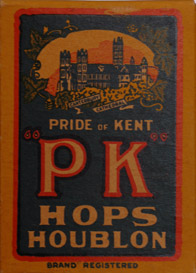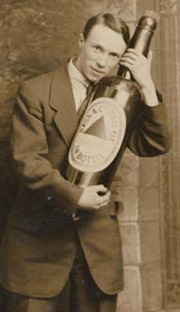 Can beer be a luxury and a blue collar product?
Can beer be a luxury and a blue collar product?
The rather lengthy discussion — and you thought I wasn’t capable of understatement — Alan provoked by arguing craft beer prices are not too low goes to one of the reasons this blog exists. That’s explained in the mission statement, one of the regularly appearing categories here is “What should you pay?” and there’s a link on the right to a story asking the same question.
The article was written in 2005 for All About Beer magazine, a consumer publication. It drew from a story written a year earlier for New Brewer, the trade publication for Brewers Association members. Although Alan began the discussion from the viewpoint of a consumer plenty of business related chatter quickly followed — including contributions from brewers Eric Wallace and Tomme Arthur — so indulge me as I offer something written basically for the trade. I hope it is relevant to the ongoing discussion.
These are excerpts, and may abruptly jump from one point to another, but it beats slogging through the whole article.
The concept of “trading up” received much attention this year, from Fast Company to BusinessWeek after publication of Trading Up: The New American Luxury by Michael Silverstein and Neil Fiske.
Trading Up is based on the contributions of many members of The Boston Consulting Group, where Silverstein is vice president. The book includes the findings of both quantitative and qualitative research, and offers analysis of 23 categories, including autos, home goods, food, wine and spirits, sports equipment, pet food, and lingerie; interviews with New Luxury leaders; a consumer survey and dozens of one-on-one interviews; and a literature review of more than 800 books, articles, and other materials.
Among the companies profiled is Boston Beer.
Reviews of the book are often paired it with Living It Up: Our Love Affair with Luxury by James B. Twichell. Twichell writes, “. . . one can make the argument that until all necessities are had by all members of a community, no one should have luxury. More complex still is that, since the 1980s, the bulk consumers of luxury have not been the wealthy but the middle class, your next-door neighbors and their kids.”
. . . one of the premises of Trading Up is that consumer spending is polarizing. In order to trade up in a category she really cares about, an avid cyclists might save money by trading down in some that don’t matter to her – like her brand of toothpaste or beer.
Trading up isn’t about simply moving from beer that costs $2.99 a six-pack to $7.99 craft beer.
“The competition . . . includes all mood elevators,” Silverstein said. “Quality vodka substitutes for better beer more than it does for Bud. The beer companies need to deliver innovation on taste, nutrition, health, energy, and celebration.”
In 1985, Philadelelphia Inquirer food editor Gerry Etter wrote, “Today, beer is invited everywhere. It hobnobs with vintage wines and attends formal parties, it slides effervescently into crystal glasses held by long-gowned hostesses.”
This caused another writer for the Inquirer to counter, “I’ve never hobnobbed in my life (and if I did, it was only once and with a consulting adult), and I don’t intend to start now. One doesn’t hobnob while drinking beer, one shoots the bull.”
. . . according to the authors of Trading Up, there “are no typical New Luxury spenders.”
The book introduces the concept of “rocketing.” BCG research found that almost everyone (96 percent) will pay more for at least one type of product that is of importance to them and almost 70 percent identified as many as 10 categories in which they will “rocket” – that is spend a disproportionate amount of their income.
Charging more doesn’t make a product a New Luxury. They write that to be New Luxury, a product must connect with consumers on three levels:
– There must be technical differences in design, technology or both.
– Those technical differences must contribute to superior functional performance. It really has to be better.
– Technical and functional benefits must engage the consumer emotionally.
Interuption for comment.
You may not be comfortable with seeing “technical” and “technology” used so often, so just focus on this: It really has to be better.
Resume excerpts.
“It was a reminder that the product has to be truly superior and good on its own,” (Boston Beer founder Jim) Koch said, later adding, “We’re not trying to make a pet rock of beer, but new styles that are cherished 100 years from now.”
Silverstein returns often to the topic of quality. “The beer category is crowded with a lot of wannabe’s. Both big and small. It is an industry filled with bravado and claims,” he said. “Most are not very well developed and researched. The best example is low carb beer.”
Koch cites the book when he says, “It can’t just be a marketing gimmick. It has to be rooted in product difference. Typically, it’s not just better, but uniquely so.”
. . . “At the end of the day, we all have to add something, variety or quality, to give people a reason to buy our beer,” he said. “For instance, Sam (Calagione, founder of Dogfish Head Brewery). He wasn’t among the first (microbrewers) but he’s added stuff, a whole new set of products.”
And one last excerpt that goes to the passion reflected in A Good Beer Blog.
New Luxury products are not aimed at an “average” consumer or “general” anything. They are meant for a well-defined group of core consumers with strong needs and interests.
In targeting customers, brewers must remember that. “Rocketers care about the product. They are knowledgeable,” Silverstein said. “They have been in the category for some time. They have an interest in learning. They drink on premises and want to tell their friends. They are sharers by nature.”
 Think homebrewing is difficult? Here’s a recipe for Cottage Beer:
Think homebrewing is difficult? Here’s a recipe for Cottage Beer: Might one of the side effects of
Might one of the side effects of  Can beer be a luxury and a blue collar product?
Can beer be a luxury and a blue collar product?